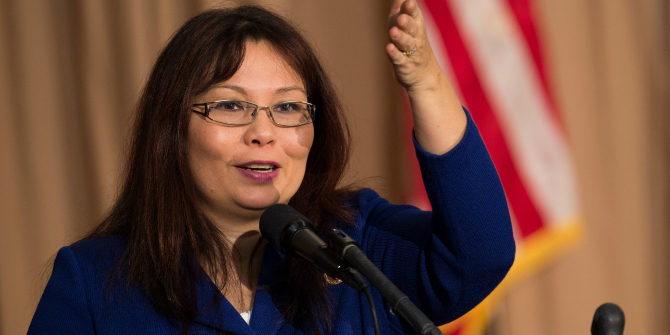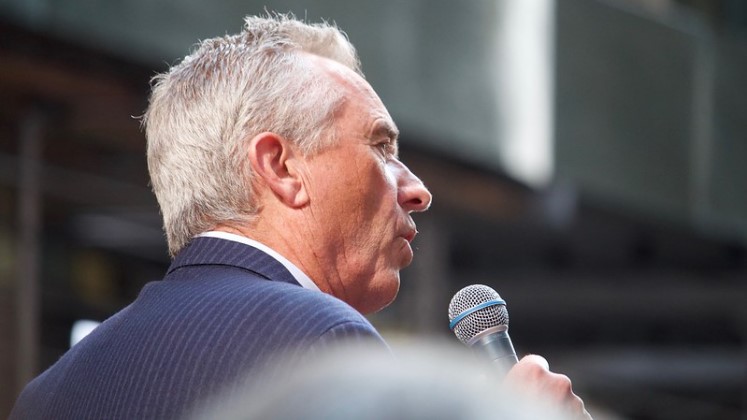 In just over two months’ time, voters in Iowa will caucus to decide their preferred candidates for the 2020 presidential nomination. Andrew D. Green explains what makes the Hawkeye State’s political decision-making unique, writing that the individualism of many residents often leads to split ticket voting. While President Trump is almost certain to win the Republican contest in Iowa, he comments, Senator Elizabeth Warren and Mayor Pete Buttigieg lead the Democratic contenders.
In just over two months’ time, voters in Iowa will caucus to decide their preferred candidates for the 2020 presidential nomination. Andrew D. Green explains what makes the Hawkeye State’s political decision-making unique, writing that the individualism of many residents often leads to split ticket voting. While President Trump is almost certain to win the Republican contest in Iowa, he comments, Senator Elizabeth Warren and Mayor Pete Buttigieg lead the Democratic contenders.
- This article is part of our Primary Primers series curated by Rob Ledger (Frankfurt Goethe University) and Peter Finn (Kingston University). Ahead of the 2020 election, this series explores key themes, ideas, concepts, procedures and events that shape, affect and define the US presidential primary process. If you are interested in contributing to the series contact Rob Ledger (ledger@em.uni-frankfurt.de) or Peter Finn (p.finn@kingston.ac.uk).
For many Americans, Iowa is considered “flyover” territory as they travel from coast to coast. On the ground, however, the Hawkeye State is currently a political hotspot as Democratic presidential candidates and their surrogates crisscross the state to position themselves for the Iowa Caucuses in February 2020. Since 1972, Iowa’s presidential caucuses have held “first in the nation” status, meaning that the state’s voters will have the first opportunity to cast votes in the 2020 presidential nomination process. Though Iowa voters certainly are not “king makers” during the nomination process, Iowa voters who venture out to participate on February 3rd will play an important role in selecting the presidential nominees for the Democratic and Republican Parties.
Why is Iowa Unique?
Iowa is an interesting political case to study for political scientists and politicos due to the competitiveness of elections in the state. A major reason why Iowa elections are competitive is the individualism of Iowa voters. As Hugh Winebrenner and Dennis Goldford argue, Iowa’s political orientation toward individualism has led to politically independent voters. As a result, split ticket voting in the state is not abnormal. In 2016, a significant number of Iowa voters in House District 2 split their votes between Donald Trump and Dave Loebsack, the incumbent Democratic Congressman, as Trump won the popular vote in the district by 4 percent and Loebsack won his race by 7 percent. Split ticket voting was also present statewide in 2018 when Iowa voters elected Governor Kim Reynolds, a Republican, to her first full term. During the same election, Iowa’s Congressional delegation shifted from three Republicans and one Democrat to three Democrats and one Republican serving in the US House.
The political independence of voters can also be seen in the significant number of “No Party Voters” registered in Iowa. According to November 2019 data from the Iowa Secretary of State, No Party Voters account for 36.8 percent of all active registered voters. 31.9 percent are registered Republicans and 30.5 percent are registered Democrats.
The competitiveness of elections has led political scientists and politicos to label Iowa a “swing state.” Donna Hoffman and Chris Larimer note that Iowa has been identified as a swing state in every presidential election since the year 2000, including during the 2016 presidential election. As I discuss in my recent book, there is a certain subset of Iowa voters who from election to election are willing to shift their votes between candidates of both parties. The 2016 election was no different when Donald Trump won the state by 9.4 percent. In doing so, he flipped 32 counties that President Barack Obama won in 2012 by an average difference of 27.6 percent.
The 2020 Iowa Caucuses
On February 3rd next year, thousands of Iowa voters will pack into school gymnasiums, churches, community centers, and other local venues to participate in the Iowa Precinct Caucuses. While the outputs of the caucuses (e.g., select delegates to the County Conventions and party platform work) are the same for both the Democratic and Republican Parties, the means through which delegates are selected vary.
Projecting the winner of the Iowa Republican Caucuses is straight-forward: Short of withdrawing from the race, President Trump should win the Iowa Republican Caucuses with a healthy margin. The most recent Emerson College Poll of registered voters in Iowa who plan to attend the Republican caucuses revealed that 93 percent intend to support Trump. The reality is that Trump is still quite popular with Republicans in the state. In the same poll, 61.4 percent of Republicans approved of Trump’s performance as president while only 9 percent disapproved. The remaining 29.5 percent were either neutral or did not have an opinion regarding Trump’s performance.

Featured image credit: DonkeyHotey (Flickr, CC-BY-2.0)
Recent polling of Iowa Democrats identifies a two-tiered race as the candidates enter the final three months of the Iowa caucus campaign. In the most recent poll from Quinnipiac University from early November, Senator Elizabeth Warren (20 percent), Mayor Pete Buttigieg (19 percent), Senator Bernie Sanders (17 percent), and Vice President Joe Biden (15 percent) round out the top-tier. The remaining candidates in the field make up the second-tier as no other candidate exceeded 5 percent support in the poll. The results of the Quinnipiac Poll are relatively consistent with the findings of the Siena College/New York Times Upshot Poll and the Iowa State University Poll, both taken in mid-October.
Additionally, it is clear from polling data that not all Iowa Democrats have made up their minds three months prior to the Iowa caucuses. According to the Quinnipiac University polling data, less than half (46 percent) of likely Democratic caucus-goers have made a final decision regarding their preferred candidate. What this reveals is that candidates in both the first and second tiers have opportunities for growth. Over the next three months, the candidates will continue to sell Iowa voters on their “viability” to win the nomination and their “electability” in a head-to-head matchup with Donald Trump in hopes of securing the votes of the remaining likely caucus-goers.
Will Trump Win Iowa in 2020?
It is certainly true that Iowa Democrats have made gains since the 2016 election. Not only did they make gains on the Congressional level in 2018, the Democratic candidate for governor, Fred Hubbell, won five Trump counties on election night. In order to win Iowa, however, Democrats will need to nominate a candidate who can win back votes, particularly in eastern Iowa, and is willing to develop a message that resonates with rural Iowa voters.
It will be a tall task, nonetheless. As I wrote in my book on Trump’s 2016 electoral victory in Iowa, Trump was the frontrunner heading into the 2020 election cycle. That prediction is still valid nearly six months after finalizing the manuscript. In hypothetical head-to-head matchups with the four Democratic candidates in the first-tier from the most recent Siena College/New York Times Upshot Poll, Trump is favored by 6 percent over Warren, 4 percent over Buttigieg, 3 percent over Sanders, and 1 percent over Biden. While the differentials are small, they indicate that Trump will be a formidable incumbent regardless of the Democratic nominee.
Please read our comments policy before commenting.
Note: This article gives the views of the author, and not the position of USAPP – American Politics and Policy, nor of the London School of Economics.
Shortened URL for this post: http://bit.ly/2OJ7XJr
About the author
 Andrew D. Green – Central College
Andrew D. Green – Central College
Andrew D. Green is a Professor of Political Science at Central College in Pella, IA. Dr. Green completed his BA in political science at Wartburg College (IA) and his PhD in political science at The University of California, Riverside. His research focuses primarily on state and local politics and policy, and he has been published in journals such as State Politics and Policy Quarterly, State and Local Government Review, and California Journal of Politics and Policy. Dr. Green is also the author of From the Iowa Caucuses to the White House: Understanding Donald Trump’s 2016 Electoral Victory in Iowa, a book published in August 2019.







The analysis of the 2020 Democratic Presidential campaign has missed a huge point. A candidate will have to get 51% of the votes at the convention. For the entire campaign, so far, it seems apparent that no candidate has much of a chance to reach that level of support. Occasionally, a candidate gets to a little over 30%, but they drop back to the point where the leaders have the support of around 20% to 25%, nowhere near 50%. In other words, no matter which candidate you talk about, around 75% to 80% of those polled favor someone else. This is not because the candidates (except for Joe Biden) are poor candidates. It is the opposite. The problem is that there are a lot of good candidates (not Joe Biden) who are able to attract support, and thus split the vote so far. As to Joe Biden, has stays at around 20% because he has been a good guy with a really good career, but he can’t get beyond 20% or so because he is a bad candidate at this time. He has way too many flaws and they will always catch up with him. So, you have Joe Biden, who hangs on to 20% support but can’t get past that and you have Bernie and Elizabeth with about 20% each. They cancel each other out, in a way, with Progressive voters, and neither one of them will drop out before the convention. Even if one did, the two combined only garner about 40%. About 60% want a moderate. Biden hangs on, preventing another moderate from moving forward, but he has too many flaws. That leaves 7 to 12 other candidates to fight for the remaining 40%. If ten of them each get about 4% (roughly that is the case) that is where we sit for now. At the convention, a moderate is most likely to win. That moderate is not Joe Biden. He has way too many flaws. I would really like to see analysis of this perspective, rather than the simple horse race coverage identifying three or four so called “leaders”. Keep in mind that, as to any of those “leaders”, 75% to 80% of the people support someone else. The more the field narrows, the more likely that a moderate (not Joe Biden because he has way too many flaws) will start to gain momentum and perhaps that candidate will be the one to consolidate the moderate (60% or so) support at the convention. If we see a moderate get into the low 40% range, that candidate will most likely be the winner. That will be real news worth covering. So called “leaders” unable to get past 25% are not really likely to win.